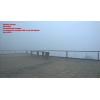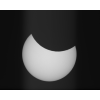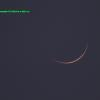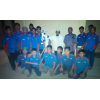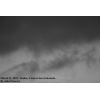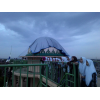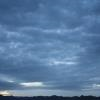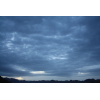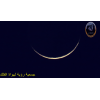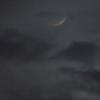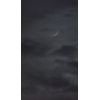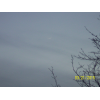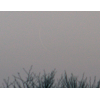Visibility of Jumadal Al-Aakherah Crescent 1436 AH
- When to Observe Jumadal Al-Aakherah Waxing (NEW) Crescent ?
- Jumadal Al-Aakherah Waxing (NEW) Crescent Observation Results
- The OFFICIAL First Day in Different Countries
- When to Observe Jumadal Al-Aula Waning (OLD) Crescent ?
- Jumadal Al-Aula Waning (OLD) Crescent Observation Results
When to Observe Jumadal Al-Aakherah Waxing (NEW) Crescent ?
The geocentric conjunction (Geocentric New Moon) will occur Inshalla on (Friday 20 March 2015) at 09:36 UT.
Sighting the new crescent on (Friday 20 March 2015) and (Saturday 21 March 2015) is shown in the below graphs using the program Accurate Times by Mohammad Odeh according to Odeh criterion. Where:-
- It is impossible to see the crescent from the areas located under the red color. Because either the Moon on this day sets before the Sunset and/or the topocentric conjunction occurs after the Sunset.
- The crescent is expected to be seen by optical aid only from the areas located under the blue color.
- The crescent is expected to be seen by optical aid from the areas located under the magenta color. In these areas the crescent could be seen by naked eye if the atmospheric conditions are superb and the observer is experienced.
- The crescent is expected to be easily visible by naked eye from the areas located under the green color.
- The crescent cannot be seen from uncolored areas, even though the Moon sets in these locations after the Sunset and the topocentric conjunction occurs before the Sunset, but the Moon is not sufficiently illuminated in order to be seen as crescent even by optical aid.
- Kindly notice that the below graph shows the possibility of seeing the crescent from areas between 60 degrees north of Equator down to 60 degrees south of Equator.
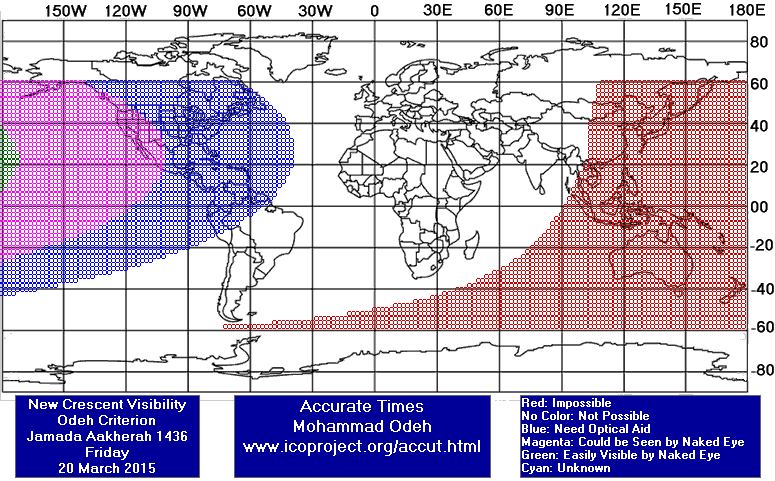

According to the Universal Hejric Calendar (UHC), which is based on the calculated crescent visibility, the start of this month in the Eastern Region will be on Sunday 22 March 2015 and in the Western Region will be on Saturday 21 March 2015. Kindly notice that the UHC is a pre-calculated calendar, which adopts a certain criterion to start the new Hejric month. Your country/organization might adopt different criterion to start the new Hejric month. So it is highly advised to read the UHC website before giving any judgment.
- Results of seeing the crescent, and the first day of the month in different countries will be added here Inshalla as we receive the reports from ICOP's members. If you wish to be a member in ICOP, or to know more about it, kindly click here.
Jumadal Al-Aakherah Waxing (NEW) Crescent Observation Results
Fri 20 March 2015
France
Mr. Farid Fofana said: "لمزيد من المعلومات و لمشاهدة التقارير الأخرى، يرجى زيارة موقع WWW.OLMF.FR"
Germany
Eng. Martin Elsaesser said: "The partial solar eclipse could be observed very well here from Munich, Germany. The moon passed north of the center of the sun, leaving a nice crescent-shaped part of the sun visible. We demonstrated the event to dozens of school-children. Of course we did not see a crescent of the moon, but rather the moon in front of the sun, leaving a crescent shaped part of the sun visible. The image shows the maximum occultation, shortly after geocentric conjunction."
Libya
Eng. Mohamed Mogerby said: "تمت محاولة رؤية الهلال لكن كان الجو ليس صافي ومرفق لصورة الكسوف في طرابلس ."
Saudi Arabia
Eng. Qamar Uddin said: "I was visiting Madinah on Friday 20 March 2015 and decided to join a local group of observers who were fully equipped with binoculars, telescope and CCD camera mounted instruments. We did not see the crescent even though the western horizon was very clear. There was a solar eclipse a few hours earlier, but since the moon set was after sunset in Makkah, the month of Jumada Al-Thani 1436 may start from the next day (21 March 2015) in Saudi Arabia as per the Ummul Qura calendar."
United States
Dr. Javad Torabinejad said: "The sky was mostly cloudy; thus, no serious attempt was made to sight the crescent with optical aids. According to visibility curves, there was no way to sight the moon with naked eyes."
Sat 21 March 2015
Australia
Bangladesh
France
Mr. Farid Fofana said: "لمزيد من المعلومات و لمشاهدة التقارير الأخرى، يرجى زيارة موقع WWW.OLMF.FR"
Hungary
Indonesia
Mr. AR Sugeng Riyadi said: "Bismillahirrahmanirrahiim: The new crescent of Jumadal Akhirah 1436 AH was NOT SEEN from Surakarta Central Java Indonesia, on Saturday 21st March 2015. We were several teachers and students of CASA (Club Astronomi Santri Assalaam), some students of SMA Al-Islam 1 Surakarta at Assalaam Observatory, Kartasura Sukoharjo, and about 60 students of "Hisab - Rukyat Hilal Workshop" at Ma'had Darul Fithrah Grajekan Tawangsari Sukoharjo Central Java Indonesia. The sun was covered by clouds about an hour before setting time and it's raining all night at two places we hold the hilal sighting in Sukoharjo. Anyway, my student Rossiana Nur N reported that She could see the crescent by naked eye at Denpasar Bali Indonesia but the thick clouds covered the moon before She could take a pic. Mr. Joko Prasetyo at Al-Buruj Observatory also reported that the crescent was SEEN from Kudus Central Java Indonesia. The first day of Jumadal Akhirah 1436 in Indonesia will start on Sunday 22th March 3015."
Iran
Mr. Hossein Janghorbani said: "In the name of God Jumadal Thani Crescent Observation Report Astronomy and Geophysics Center of Shahreza – The Crescent Association of Shahreza Report by: Hossein Janghorbani (Najm-al-Sepehr) – Manager of Shahreza Crescent Association and Red Crescent’s Astronomy and Geophysics Center Date: Saturday, 3/21/2015 Location: Damzad foothills in the East of Shahreza (latitude: 32 00 N, longitude: 51 52 E, elevation: 1825m from sea level, time zone: +3.5 GMT) Equipments: two set of 15*70 , one compass. Atmospheric condition: Partly cloudy in western horizon. Horizon obstacles: about 2° Apparent sunset: 18:3 Results: Moon crescent was not seen because was clouds in western horizon. Observers : 1.Ahmad Reza Hamidia 2.Mahdi Ghasemi 3.Reza Janghorbani 4.Ali Janghorbani 5.Hossein Janghorbani 7.Zahra Farrokhpoor 8.Neda Hamidia "
Libya
Eng. Mohammed Abdulkarim said: "تمت رؤية الهلال بسهولة بعد عشر دقائق من غروب الشمس جمعية رؤية لهواة الفلك https://www.facebook.com/visionthemoon"
Morocco
Nigeria
Dr. Z.Sani Mustapha said: "THE SKY WAS FOGY NOT A SINGLE STAR SEEN."
Mr. Yunusa Yakubu said: "There exist a very poor Visibility in Bauchi. the sun was covered by cloud an hour before setting time and presently it's raining."
Saudi Arabia
South Africa
Dr. Abdurrazak Ebrahim said: "Hilaal observed per naked eye from my residence in the Zeekoevlei Nature Reserve, 25 km south east of Cape Town at 7:13 pm local time (16 minutes after local astronomical sunset)."
Sri Lanka
Mr. Nular Bary said: " Assalamualaikum W R W B. Today 29th.of Jumada-al-Oola 1436H (21/03/2015) evening the Colombo western sky was patchy and I couldn't see the New Moon of Jumada-at-Thania till 7:15Pm. as our Sunset was today at 6:21Pm and the Moonset was at 7:22Pm. (276°NW) Moonset 61mts.after Sunset at the age of 28h:16mts.Anyway our Colombo Grand Mosque Hillal committee received several positive naked eye sighting mainly from Jaffna (north) Putalum and some other eastern towns. Hence our Committee decided to start the month of Jumada-at-Thania 1436 Tomorrow Sunday 22th. March 3015 "In Sha Allah" Nular Bary (member of C.G.H.C.) Colombo Sri Lanka."
United States
Dr. Javad Torabinejad said: "The first naked eye sighting was at 7:31 pm EDT (sunset: 7:34 pm). The sighting time could have been earlier, if I looked for the crescent. The horns were at 3:00 and 7:30 O'clock (3:00;4:00;7:30). The western horizon was partly cloudy and hazy. At 8:50 pm, the moon was still up and behind a thin layer of cloud (moonset: 9:21 pm)."
The OFFICIAL First Day in Different Countries
Sun 22 March 2015
1 . Bangladesh
2 . Indonesia
3 . Iran
4 . Libya
5 . Morocco
6 . Nigeria
7 . South Africa
8 . Sri Lanka
Mon 23 March 2015
1 . Australia
When to Observe Jumadal Al-Aula Waning (OLD) Crescent ?
The geocentric conjunction (Geocentric New Moon) will occur Inshalla on (Friday 20 March 2015) at 09:36 UT.
Sighting the OLD crescent on (Friday 20 March 2015) and (Thursday 19 March 2015) is shown in the below graphs using the program Accurate Times by Mohammad Odeh according to Odeh criterion. Where:-
- It is impossible to see the OLD crescent from the areas located under the red color. Because either the Moon on this day rises after the Sunrise and/or the topocentric conjunction occurs before the Sunrise.
- The crescent is expected to be seen by optical aid only from the areas located under the blue color.
- The crescent is expected to be seen by optical aid from the areas located under the magenta color. In these areas the crescent could be seen by naked eye if the atmospheric conditions are superb and the observer is experienced.
- The crescent is expected to be easily visible by naked eye from the areas located under the green color.
- The crescent cannot be seen from uncolored areas, even though the Moon rises in these locations before the Sunrise and the topocentric conjunction occurs after the Sunrise, but the Moon is not sufficiently illuminated in order to be seen as crescent even by optical aid.
- Kindly notice that the below graph shows the possibility of seeing the crescent from areas between 60 degrees north of Equator down to 60 degrees south of Equator.

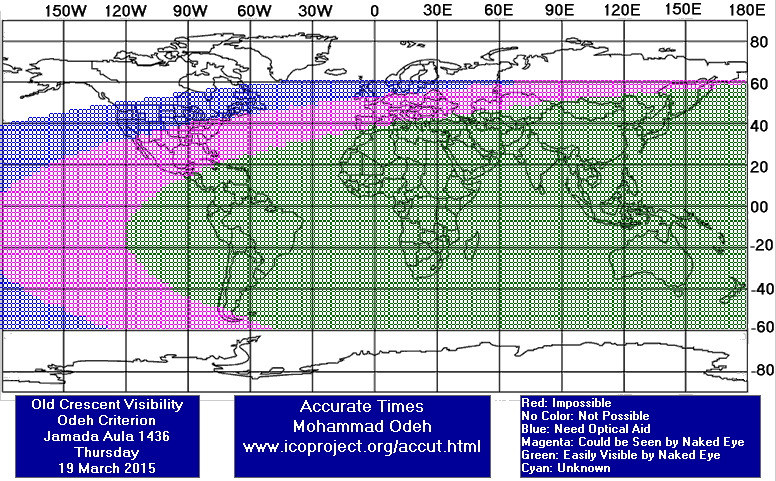
Jumadal Al-Aula Waning (OLD) Crescent Observation Results
Thu 19 March 2015
Germany
Eng. Martin Elsaesser said: "There was some humidity and haze on the eastern horizon. As the crescent was low despite the large elongation i could not see it with the naked eye. With 12x50 binoculars i could see it but it was not easy. I also had to stretch the contrast in the simple images i took to make it visible. The weather forecast for the partial eclipse tomorrow is quite good so we expect a nice show and many visitors at our public observatory."
Indonesia
Mr. AR Sugeng Riyadi said: "Alhamdulillah, My students (Fatma Arum and Hibah Al-Izzati) could see the old crescent of Jumadal Ulaa 1436 AH from Assalaam Observatory in PPMI Assalaam Sukoharjo Central Java Indonesia, on Thursday, March 19th, 2015. But they could not able to take a picture because the crescent was covered by some clouds. At the same time I also could see the waning crescent of Jumadal Ulaa 1436 AH from my Personal Observatory in Ketitang Juwiring Klaten Central Java Indonesia. The crescent was first seen after shubuh praying at 04:50 LT about 30 minutes after Moonrise and it last seen at 05:15 LT because some clouds. The waning crescent of Jumadal Ulaa 1436 AH also seen from Tangerang West Java, by my friend Zunaidi (mr. Juned). But it was not seen from Kudus Central Java, by mr. Joko P because very cloudy."
Nigeria
Dr. Z.Sani Mustapha said: "The crescent was not seen up to 6.15 a.m. But the crescent was sen yesterday at around 5.57 a.m. It was a thin crescent. I expects to see it today according to hisab. But atmospheric conditions made it impossible. "
